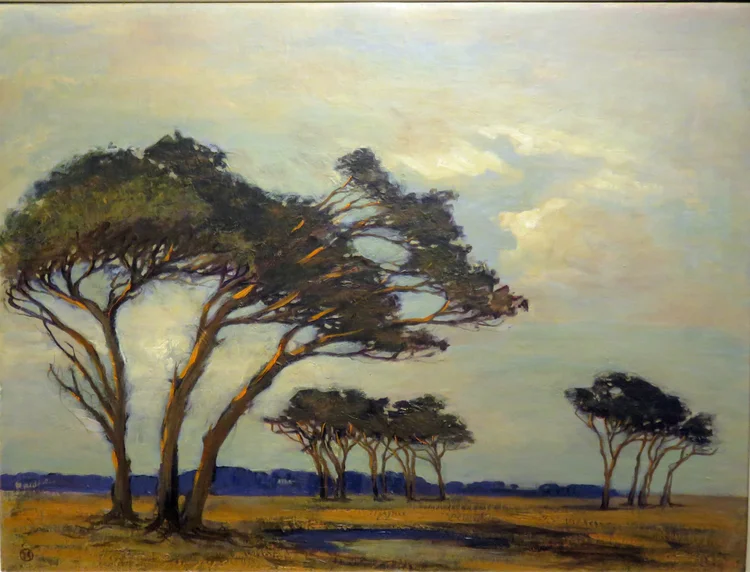In the seventeenth century, Europe's art academies defined classical art as the standard for all artistic achievement. Throughout the Mediterranean stood the ruins of ancient monuments, and droves of tourists visited Italy on the Grand Tour to visit these relics of antiquity. These ruins held a particular allure for painters, who sought to capture these picturesque scenes, redolent of past and present, and of growth and decay. For example the great pastoral French landscape painter, Claude Lorrain, often incorporated ruins and subjects of antiquity in his landscape paintings. His paintings were not intended to represent real places but to demonstrate the harmony of the man-made, and natural, environment.
No doubt, Nita Spilhaus, having been schooled in Munich, and the Art Colony of Dachau, by teachers who understood well the history of landscape painting, would have been steeped in this tradition. Even after she moved to the Cape, on her visits to Europe she often took the opportunity to draw or paint scenes, particularly Italianate, incorporating classical ruins. A scene which held particular fascination for Nita was the Tomb of Cecilia Metella on the Via Appia just outside Rome. This mausoleum commemorates the wife of Crassus, a Roman general, but in fact celebrates the greatness of her patrician family, the Metellus clan, as almost nothing is now known of the woman herself.
This subject had caught the eye of a number of painters before Nita, and examples are shown above of paintings of the same subject, executed much earlier (in the 17th and 18th Centuries) the one by the Flemish painter, Paul Bril, and the other by the Italian, Carlo Labruzzi. Nita painted this scene of the tomb on the Via Appia in 1923, and then returned, and depicted it again, in 1937. She approached the scene in a naturalistic way, but, was less interested in the architectural detail of the monument, and rather she focussed on capturing the effects of light on the landscape, the ruin and the surrounding trees. She used individual dabs of pure colour to convey atmospheric effects. Typical of Nita's landscape painting, and a technique harking back to 17th Century Dutch landscape painting, is the low horizon and big-sky vista. She used earthy colours and contrasting light and dark.
In one instance, Nita painted this subject twice on a double-sided canvas: One on the front (recto) and the other on the reverse side (verso) .
This double-sided painting (recto and verso) is one of only two examples of this that I have found amongst Nita’s work, but it was a practical way to paint “plein air”, as the artist could take out a double sided canvas for a day’s painting, and paint a scene on both its sides . No doubt Nita preferred the painting on the recto side, and this is the side that is currently framed. But, regrettably, this recto painting has been over-restored, and some of the subtlety , and nuance, of Nita’s original rich colours have been lost. The colours are more vibrant, and the painting is more atmospheric, on the verso side. I know which I prefer!
Other works of Nita Spilhaus also depicting the Tomb of Cecilia Metella, Via Appia, Rome


